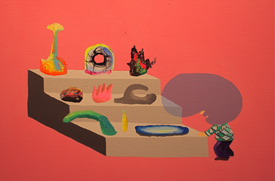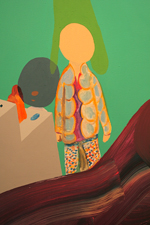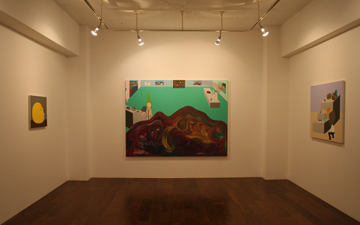 |
|
 |
Rock Gallery (2008), acrylic gouache on canvas
Courtesy of Gallery Side 2 |
|
Detail, acrylic gouache on canvas
Photo by Roger McDonald |
|
Fresh from having won the First Prize of the prestigious John Moores 25 Contemporary Painting Prize (awarded in Liverpool last September; previous first prizewinners include David Hockney and Peter Doig), Peter McDonald presented new works on canvas, a new suite of three lithographs made in Tokyo, and smaller drawings in his exhibition at Tokyo's Gallery Side 2. (Disclosure: Peter McDonald is the writer's brother.)
The exhibition consisted largely of paintings depicting stores selling rocks and minerals, one genre among the many that McDonald paints. Rocks and minerals are manifestations of ancient complex processes that take place over thousands of years, such as crystallization, solidification and layering. The rich surfaces of minerals function as archives that have captured the sedimentation of time. They are hyper-spatial, hyper-temporal nuggets of cosmic documentation. Rocks are superb teachers that return a sense of perspective to our own historical epoch. They are perhaps one of the few materials capable of evoking this sublime sense, in an age of almost total spectacle. Their depiction in these new paintings provides one context within which to ponder the fate of painting today, one not narrowly tied to a Modernist canon, but which must also necessarily embed itself in a mineral-like geological matrix that remains open to many different sources, references and images. Like the rocks that McDonald depicts, painting can also be considered as an archaic human endeavor of sedimentation and complexification.
The rocks in McDonald's paintings serve a crucial function. They allow the artist to paint across many different styles and schools of painting: color field, abstract, psychedelic, cartoon, interior. The rocks act as supports on which McDonald's images begin to sediment and crystallize into a multitude of forms. In doing this, the images never become "pure," relying only on one painting schema or codex. A sense of play is maintained, and the act of looking is also one of negotiating and excavating the very histories of painted images themselves. In the largest painting presented at Gallery Side 2, the foreground is taken up by a massive globular abstract form that rises up from the ground. Like the famous feet paintings by the Japanese Gutai painter Kazuo Shiraga, this mound of swirling juicy paint is a rock up close. It gives way to an interior view of a shop in which we see other compact mineral abstractions on shelves. The entire scene is painted within the tight formal arrangement of what could be a color field painting by Ellsworth Kelly. Furthermore, the scene is inhabited by people with swelling transparent heads that suggest telepathic abilities, but which also act as formal devices that result in overlapping color palettes, reminiscent of the colorful astral bodies illustrated by the theosophist Charles Leadbeater in the late 19th century. Considering the occult roots of modern painting in the work of such artists as Piet Mondrian and Wassily Kandinsky, McDonald's "subtle bodies" perhaps point to and humorously depict a realm of Cosmic Higher Selves as dreamed of by so many painters.
Painting today probes a unique zone within art-making, simultaneously looking back into the vast database of image forms that is now available to us at the click of a mouse and, to borrow a phrase used by the philosopher Felix Guattari, de-territorialize these forms so that they form the strata for new images in the present. McDonald's rock works remind us of this memory-making capacity of painting by cleverly borrowing mineral forms to peer back into the always infinite and cosmic dimensions that lie embedded within the act of making marks on flat surfaces.
 |
|
 |
Rock Gallery (2008) detail, acrylic gouache on canvas
Photo by Roger McDonald |
|
Installation view, Gallery Side 2
Photo by Roger McDonald |
|
|
|
|